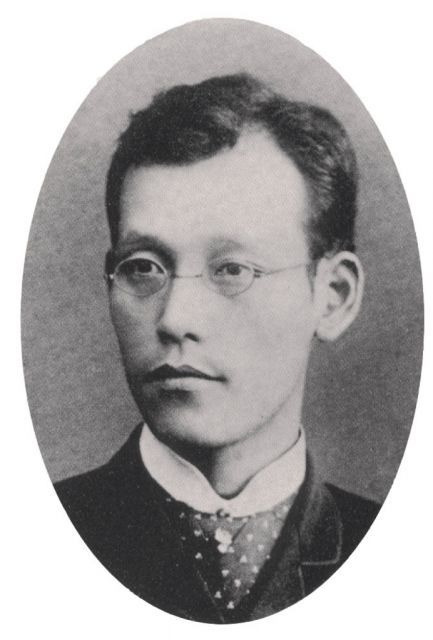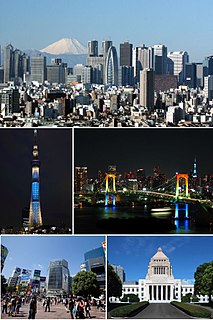
Nichiren Shōshū is a branch of Nichiren Buddhism based on the teachings of the 13th-century Japanese Buddhist priest Nichiren (1222–1282). Nichiren Shōshū claims Nichiren as its founder through his disciple and secretary Nikko Shonin (1246–1333), the founder of the school's Head Temple Taiseki-ji, located at the base of Mount Fuji. Nichiren Shōshū has adherents around the world, with the largest concentration in Japan. The Enichizan Myohoji Temple located in Los Angeles, California serves as the organization's headquarters within the United States.

Namu Myōhō Renge Kyō (南無妙法蓮華經) is the central mantra chanted within all forms of Nichiren Buddhism.

Soka Gakkai is a Japanese Buddhist religious movement based on the teachings of the 13th-century Japanese priest Nichiren as taught by its first three presidents Tsunesaburō Makiguchi, Jōsei Toda and Daisaku Ikeda. It is the largest of the Japanese new religions and holds the largest membership among Nichiren Buddhist groups. "The Gakkai" bases its teachings on Nichiren's interpretation of the Lotus Sutra and places chanting "Nam Myōhō Renge Kyō" at the center of devotional practice. The organization promotes its goals as supporting "peace, culture, and education".
Buddhism in Japan has been practiced since its official introduction in 552 CE according to the Nihon Shoki from Baekje, Korea, by Buddhist monks. Buddhism has had a major influence on the development of Japanese society and remains an influential aspect of the culture to this day.

Nichiren Shū is a combination of several schools ranging from four of the original Nichiren Buddhist schools that date back to Nichiren's original disciples, and part of the fifth:

Gohonzon is a generic term for a venerated religious object in Japanese Buddhism. It may take the form of a scroll or statuary. In Nichiren Buddhism, it refers to the hanging calligraphic paper mandala inscribed by Nichiren to which devotional chanting is directed.

Nipponzan-Myōhōji-Daisanga (日本山妙法寺大僧伽), often referred to as just Nipponzan Myohoji or the Japan Buddha Sangha, is a Japanese new religious movement and activist group founded in 1917 by Nichidatsu Fujii, emerging from Nichiren Buddhism. "Nipponzan Myōhōji is a small Nichiren Buddhist order of about 1500 persons, including both monastics and lay persons." The community reveres the Lotus Sutra as the highest expression of the Buddhist message.

Risshō Kōsei Kai (立正佼成会); until June 1960, 大日本立正交成会 is a Japanese new religious movement founded in 1938 by Nikkyō Niwano and Myōkō Naganuma. Risshō Kōsei Kai is organized as a lay Buddhist movement, which branched off from the older Reiyūkai, and is primarily focused around the Lotus Sutra and veneration of ancestors.

Tanaka Chigaku was a Japanese Buddhist scholar and preacher of Nichiren Buddhism, orator, writer and ultranationalist propagandist in the Meiji, Taishō and early Shōwa periods. He is considered to be the father of Nichirenism, the fiercely ultranationalistic blend of Nichiren Buddhism and Japanese Nationalism espoused by such figures as Nissho Inoue, Kanji Ishiwara and Ikki Kita. Notably, however, the children's writer, poet, and rural activist Kenji Miyazawa also idolized Tanaka, and both Miyazawa and Ishiwara joined his flagship organization, the Kokuchūkai, in 1920.

The Honmon Butsuryū-shū (本門佛立宗) is a branch of Honmon Hokke Shū sect. It was founded by Nagamatsu Nissen and a group of followers the 12th of January 1857 with the name of Honmon Butsuryu Ko. This group was affiliated with Honmon Hokke shu sect until the 15th of March 1947 when it became independent with the name of Honmon Butsuryū-shū. In fact, they shared the same Patriarch until 1947. The last common patriarch was Nichijun Shonin.
Viśiṣṭacāritra is a bodhisattva mentioned in the 15th, 21st, and 22nd chapters of the Lotus Sutra. He is one of the four great perfected bodhisattvas who attends Gautama Buddha and protects the Lotus Sutra and its devotees. The other three are Anantacaritra, Visuddhacaritra, and Supratisthitacaritra; together they make up the four great primarily evolved bodhisattvas. Viśiṣṭacāritra is also believed to represent the "true self" characteristic of buddhahood, which is the selflessness of Nirvana.

Fuji Taiseki-ji Kenshōkai is a Japanese new religious movement derived from Nichiren Buddhism. Kenshōkai was founded as a lay group affiliated with Nichiren Shōshū in 1942 in the Myokoji Temple in Shinagawa ward in Tokyo, and was originally called Myōshinkō (妙信講). After engaging in conflict with fellow Hokkeko members, it transferred to Myoenji Temple in Sumida, Tokyo. It upholds the Taiseki-ji Head Temple to possess the true Dai Gohonzon of Nichiren, although it does not itself control Taiseki-ji. The current headquarters are located in Junō-chō, Ōmiya-ku, Saitama Prefecture.

Bussho Gonenkai Kyōdan (佛所護念会教団) is an offshoot of Reiyūkai and branch of Nichiren Buddhism. It was founded in 1950 in Japan by Kaichi Sekiguchi and his wife Tomino Sekiguchi.

Kōsen-rufu (広宣流布), a phrase found in the Japanese translation of the Lotus Sutra, means the future widespread dissemination of the Lotus Sutra. The term derives from its Yakuō 23rd chapter: "Propagate this chapter widely throughout the Jumbudvipa in the last 500-year period after my death." Nichiren (1222–1282) took this statement to indicate that the Lotus Sutra is the Law to be declared and widely spread during the Latter Age.
The Myōdōkai Kyōdan (妙道会教団) is a Japanese Buddhist lay organisation that stems from the Reiyūkai, a branch of Nichiren Buddhism. It was founded in 1951 and has approximately 219,000 adherents, most of whom are in Japan. The current president of Myōdōkai Kyōdan is Keiji Sahara. The organistaion's headquarters are in Tennōji, Ōsaka. One of its core teachings is the belief in the Lotus Sutra.
Bodhisattvas of the Earth, also sometimes referred to as "Bodhisattvas from the Underground," "Bodhisattvas Taught by the Original Buddha," or "earth bodhisattvas," are the infinite number of bodhisattvas who, in the 15th chapter of the Lotus Sutra, emerged from a fissure in the ground. This pivotal story of the Lotus Sutra takes place during the "Ceremony in the Air" which had commenced in the 11th chapter. Later, in the 21st chapter, Shakyamuni passes on to them the responsibility to keep and propagate the Lotus Sutra in the feared future era of the Latter Day of the Law.













